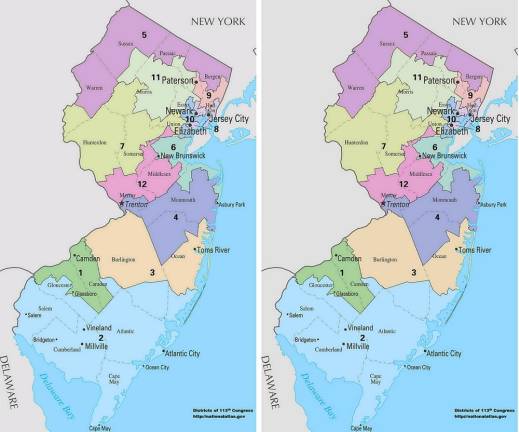NJ selects new congressional district map drawn by Democrats
Redistricting. The Dec. 23 vote is a result of the federal census. New Jersey’s population grew from 8.8 million people a decade ago to 9.3 million, a nearly 6% increase.

(AP) The bipartisan New Jersey commission charged with drawing the boundaries for congressional districts for the next decade voted Dec. 23 to approve a map put forward by Democrats.
The vote was 7-6, with Democrats in favor and Republicans opposed. Former Supreme Court Justice John Wallace, the 13th and tiebreaking member of the commission, sided with Democrats. He said the decision came down to the Republican map winning 10 years ago and that, to be fair, Democrats should win this time.
The new map could result in a nine to three Democratic advantage in the state’s 12 U.S. House seats, according to the GOP, though the Democrats did not concede the breakdown. Currently, Democrats hold 10 seats to the GOP’s two. Before Democratic pickups up in 2016 and 2018, the map was split evenly, with Democrats and Republicans each holding six seats.
Democratic commission chairwoman Janice Fuller said her party was “uncomfortably comfortable” with the outcome. She said she didn’t consider the map to unfairly benefit Democrats and suggested there was political risk for some incumbent Democrats.
“We did not go in with an extreme gerrymandered partisan Democratic map that we were gonna tweak at the edges,” she said.
Republican commission chairman Doug Steinhardt said he was disappointed with the vote which he said was the “antithesis” of empowering voters.
The 5th District, where Democrat Josh Gottheimer unseated a Republican incumbent in 2016, no longer has Warren County towns but added a few in Bergen County, the state’s biggest county, where Democrats have performed well recently.
The new map also includes a reshuffle of the typically competitive 3rd District, which previously included Burlington and Ocean counties and is represented by Democratic Rep. Andy Kim. Ocean County was removed entirely from the district and replaced with parts of Mercer and Monmouth, which could help him in a reelection effort as Ocean County is a GOP stronghold. Kim’s victory in 2018 was a Democratic gain from Republicans.
Another change is the addition of all of GOP-leaning Warren County to the 7th District, which is currently represented by Democrat Tom Malinowski. Malinowski picked up the seat in 2018 for the Democrats, defeating Republican Leonard Lance.
Wallace said he used a handful of criteria to guide his decision, including that boundaries should be geographically whole where possible, and that political subdivisions by town should be maintained. He also said to conform with the federal Voting Rights Act, the map must have sufficient numbers of “majority minority” districts _ or places where nonwhite voters are in the majority _ and that competitive districts should be favored.
“In the end I decided to vote for the Democratic map simply because the last redistricting map was drawn by Republicans,” he said.
Steinhardt said after the meeting that Wallace amounted to a 7th Democratic member instead of a true independent.
Wallace was selected as the 13th member of the committee by the state Supreme Court under the constitution after the two parties failed to reach a consensus on the tie-breaking member. His name was put forward by Democrats. Republicans had submitted their own candidate for consideration.
Micah Rasmussen, the director of the Rebovich Institute for New Jersey Politics at Rider University, said it was hard to ignore the fact that Democrats have such a big registration advantage over Republicans.
“We have a million more Democrats than Republicans. There are only so many ways to mask the impact of that with competitive districts. You can’t negate that kind of a profound disparity in registration. You’re gonna wind up with a map that’s gonna have a Democratic advantage no matter what,” he said.
The Dec. 223 vote is a result of the federal census, which happens every 10 years, and the requirement that seats in the House be allotted to states based on their population. New Jersey’s population grew from 8.8 million people a decade ago to 9.3 million, a nearly 6% increase. The number of House seats, though, remained unchanged at 12.
The commission wrapped up its work early after holding 10 public hearings, some remotely and some in-person. The state constitution gives New Jersey until Jan. 18 to certify its map.